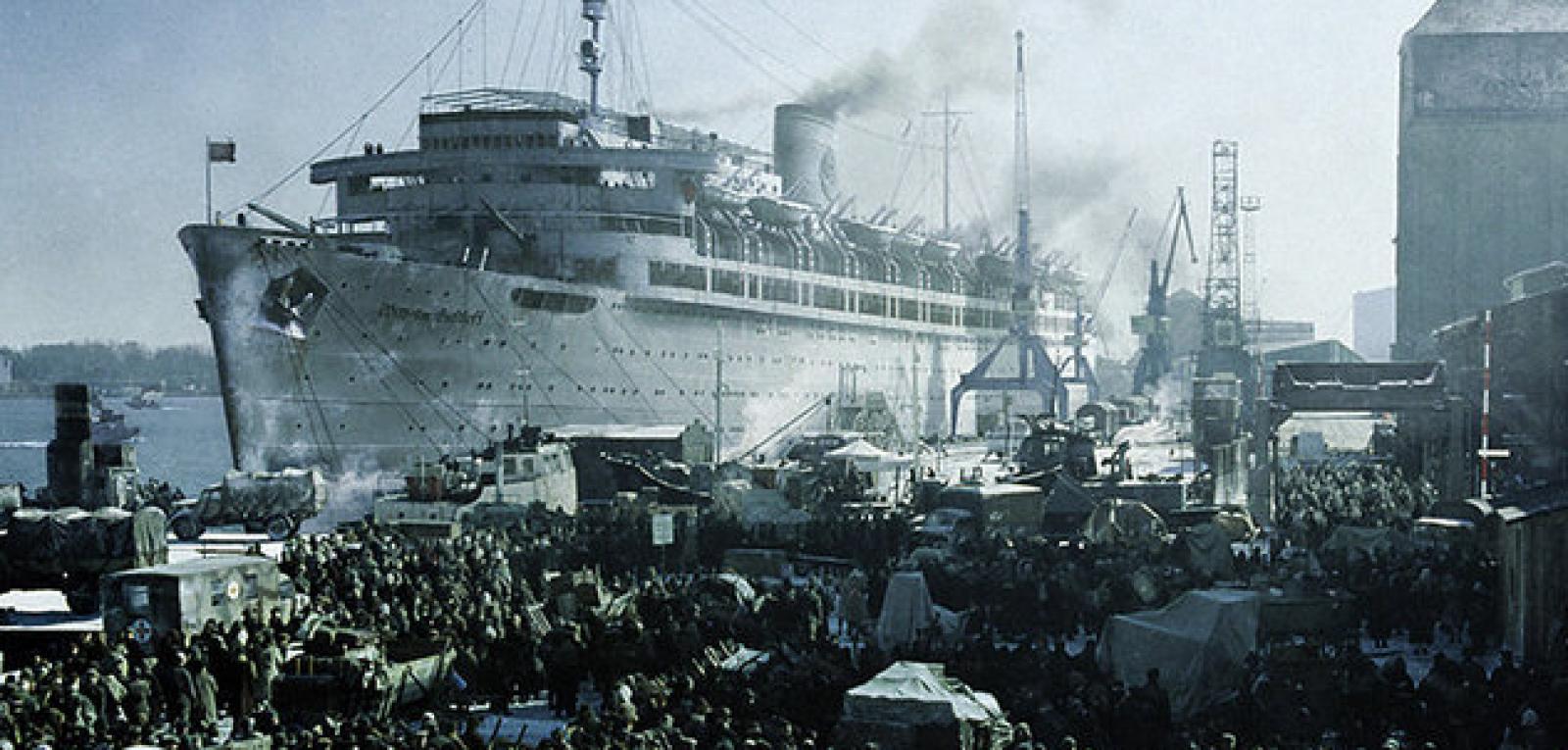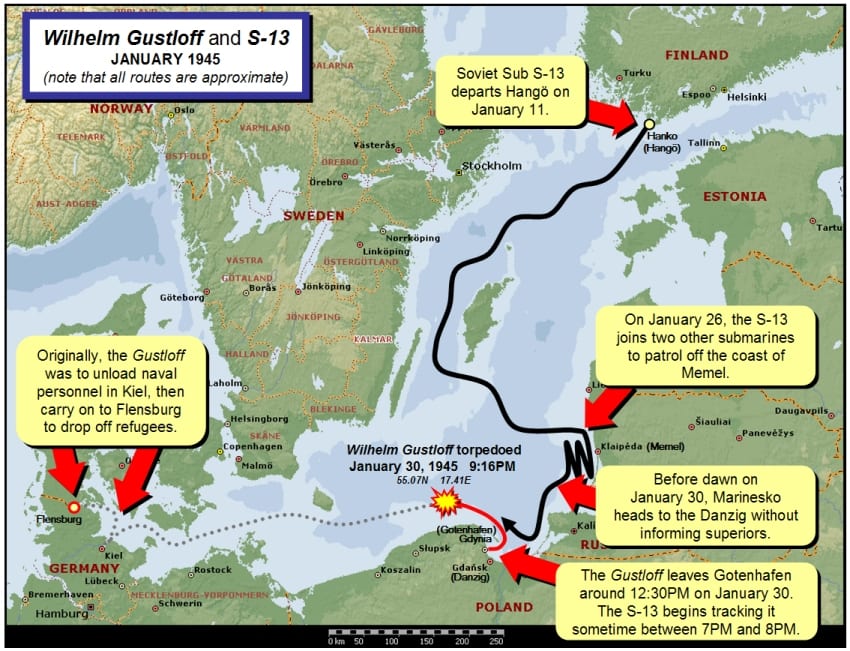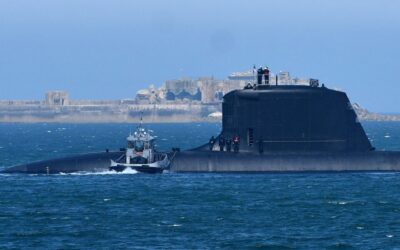HISTORY
HISTORY

The story of the sinking of the cruise liner Wilhelm Gustloff is perhaps the most tragic maritime story to date.
The chronicle of this great catastrophe begins after January 12, 1945, when the Soviet armies of the 2nd and 3rd Belorussian fronts had dangerously approached the ports of Pomerania and the Germans were forced to retreat.

From November 1940 until the beginning of 1945, Wilhelm Gustloff remained moored in Gdynia at the disposal of the submarine command there, used as a support ship (Wohnschiff) of submarine and naval base personnel.
The development of the war left no other choice to the Germans, than to immediately evacuate not only the military personnel of the naval base, but also the civilians of the area. This is how the execution of the largest operation to evacuate civilians, soldiers, wounded and most of the personnel of the German submarine command from Gdansk, Pilau and Gdynia was planned. At the same time, the Wehrmacht undertook the mission to delay the onslaught of the enemy, which destroyed the German defence.

Also read: 1st of September 1939 | Germany invades Poland- The beginning of the biggest war in History – VIDEO
For the evacuation of Gdynia, where the base of the “U II” submarine fleet was used, the hospital ships Wilhelm Gustloff and Hansa were used. On January 29, 1945, they were ready to set sail with two German torpedo boats.
The German meteorologists considered the most appropriate date of the operation to be January 30, when bad weather would prevail, believing that the sufficient speed of the ships would keep them safe against the enemy submarines in adverse weather conditions.
There is a misunderstanding as to how many passengers were aboard on that fateful night. The ship was capable of carrying 1,685 people, but the German command greatly exceeded this limit, as at least 60,000 civilians were waiting to leave Gdynia. According to the latest passenger report of the ship, she was carrying 173 crew members, 918 men of the submarine command, including doctors, 373 nurses, 162 seriously injured and 4,424 refugees (a total of 6,050 passengers).
Other sources put the number of passengers close to 10,000, a number which is not unlikely given the confusion and panic that prevailed among the civilians, who managed to occupy the last bit of free space on board.
On January 30, 1945, the ships “Wilhelm Gustloff” and “Hansa” set sail in the morning from the port of Gdynia with the support of the “T-19” and “Leve” torpedoes, which were suitable for anti-submarine warfare. The prevailing weather conditions were very bad, with temperatures -10 degrees, wind 7 Beaufort, constant snowfall and storm. Thus, three hours after the departure, the torpedo boat “T-19” notifies with a signal that it is unable to continue the coverage due to the weather conditions and returns to the port where it departed from. Thus, only Leve was left to cover Wilhelm Gustloff in its western course.
In the evening of the same day, as the two ships approached the base Hel and the lighthouse Rojevie on the Polish coast, they were spotted by the Russian submarine “S-13” whose captain was Alexander Marinesco.
The Soviet captain decided to follow the ships until he reached the right moment to engage the torpedoes. At 21:08 the “S-13” fires 4 torpedoes against Wilhelm Gustloff, of which 3 engaged their target causing surprise and panic to its passengers.
According to the survivors’ testimonies, one torpedo rendered the engine room useless, while the other two hit the hull in the bow, resulting in the instant death of 373 nurses who were in that ship compartment. The situation that prevailed was tragic and indescribable. Lifeboats were thrown ruthlessly, the ship developed a list causing panic. The flares illuminated the dark sky and the SOS signals were constantly sent by the radio operator. Leve was the first to reach the spot, but continued the search for the enemy submarine instead of coordinating the rescue.

At 22:00, Wilhelm Gustloff sank, along with her thousands of passengers. The few boats were unable to save the wrecks from the icy Baltic waters. Unfortunately for the shipwrecked, it took a long time for them to be rescued by the eight German ships, which rushed to the scene, so that they could locate survivors in the icy waters.
The spectacle was macabre, as thousands of corpses covered in ice floated. According to more recent sources, only 1239 people were rescued, whereas others speak of 996 rescued. However, the number of victims on that icy night exceeds 5,000, which, however, may rise to 8,000 if 10,000 people had actually boarded this fatal ship.
This tragedy is one of the greatest maritime tragedies in the world. For this action, Marinesco was nominated for the Soviet Union Hero award. Marinesco was honored with the award, regardless of whether the sinking of “Wilhelm Gustloff” was a war crime.
With information from: feldgrau.com
NEWSLETTER SUBSCRIPTION
Hellenic Army General Staff (HAGS) | Events for the 83rd Anniversary of the Battle of the Forts
On Sunday, April 7, 2024, the 83rd anniversary of the Battle of the Forts (April 6-9, 1941) was celebrated at “LISSE”, “RUPEL”,…
Serbia | 25 years since the NATO bombings
It has been 25 years since the start of the NATO air operation against the Federal Republic of Yugoslavia, which became known as Operation…
Remembrance Day of the Greek Jewish Martyrs and Heroes of the Holocaust
The “Remembrance Day of the Greek Jewish Martyrs and Heroes of the Holocaust” was established by a unanimous decision of…
EFA GROUP | Great Place to Work® certification for the 2nd consecutive year for EFA VENTURES, SCYTALYS and ES SYSTEMS
The companies of the EFA GROUP, EFA VENTURES, SCYTALYS and ES SYSTEMS, active in the field of Aerospace, Security, Defence and…
DEFENCE ReDEFiNED Podcast S3E12 | The Greek Defence Industry and its Potential
The 12th episode of the 3rd season of the DEFENCE ReDEFiNED Podcast hosts the President of the Hellenic Manufacturers of…
United Kingdom | French soldiers take part in guard changing ceremony at Buckingham Palace for the first time
For the first time in history, French soldiers took over the guard of Buckingham palace and participated in the guard changing ceremony.
EU | Over 4 million Ukrainian war refugees in member – states
As of February 2024, some 4.2 million Ukrainian refugees had found refuge in the EU, having been granted…
Naval Group | French Navy’s new Duguay – Trouin attack submarine enters service
The new Barracuda-class nuclear attack submarine, the Duguay-Trouin, has entered service with the French Navy, according to an…
Hellenic Army General Staff (HAGS) | Events for the 83rd Anniversary of the Battle of the Forts
On Sunday, April 7, 2024, the 83rd anniversary of the Battle of the Forts (April 6-9, 1941) was celebrated at “LISSE”, “RUPEL”,…


















0 Comments